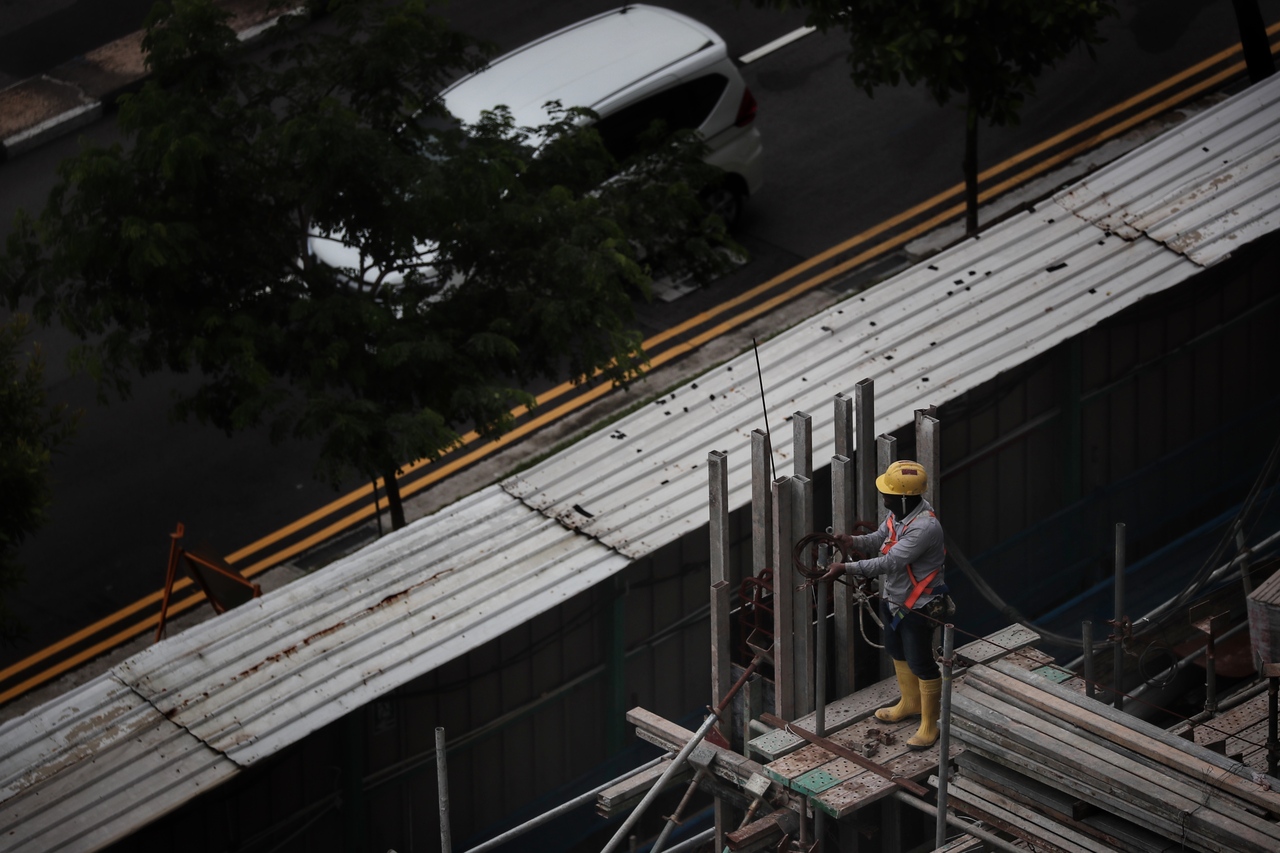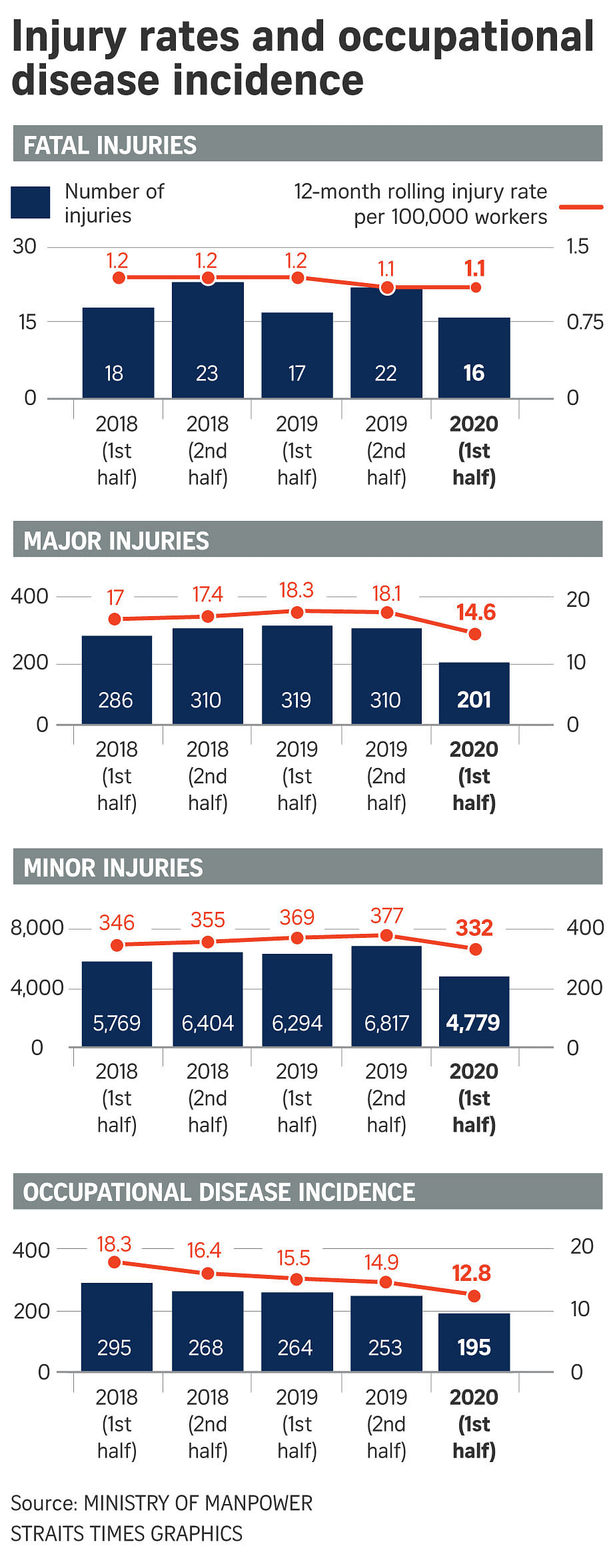Workplace injuries in first half of 2020 fall by 25% as Covid-19 caused dip in economic activity
Sign up now: Get ST's newsletters delivered to your inbox

The leading cause of fatal injuries continues to be fall from height and vehicular-related incidents.
ST PHOTO: KELVIN CHNG
Charmaine Ng, Jessie Lim
Follow topic:
SINGAPORE - Fewer people injured themselves at the workplace in the first half of this year, likely due to the suspension of selected workplace activities from April to June caused by the coronavirus.
The number of workplace injuries has fallen by nearly a quarter from 6,630 between January and June last year to 4,996 in the same period this year.
These statistics were provided by the Ministry of Manpower (MOM) and the Workplace Safety and Health (WSH) Council on Monday (Sept 28).
However, the authorities noted that there were 16 workplace fatalities this year - close to that in the first half of last year, when there were 17 deaths. In comparison, there were 22 workplace fatalities in the second half of last year.
The leading cause of fatal injuries continued to be fall from height and vehicular-related incidents, with these two concerns relevant last year as well.
Of the total number of fatalities in the first half of this year, four deaths were from falls from height - same as the same period last year.
Vehicular-related deaths fell, from four cases in the first half of last year to three cases in the same period this year.
Meanwhile, major and minor injuries were mostly caused by slips, trips and falls, though the number of such cases fell on the whole from 1,862 in the first half of last year to 1,508 in the same period this year.
The second-most common cause of major and minor injuries was related to machinery, with 809 cases this year compared to 1,119 cases in the same period last year.
MOM and the WSH Council said the transportation and storage industry accounted for the highest number of deaths - five cases - at the workplace in the first half of this year.
The 12-month fatality rate for the industry also increased, from 3.1 per 100,000 workers as of end-December last year to 3.8 as of end-June this year.

Meanwhile, workplace deaths in the construction industry fell from six cases in the first half of last year to three cases in the same period this year. There were also fewer major injuries in the industry with 26 cases this year, compared with 61 cases in the same period last year.
The manufacturing industry also had three workplace deaths in the first half of this year and was the top contributor for major and minor injuries with 40 and 971 cases respectively.
In addition, the number of dangerous occurrences - or incidents with a high potential for multiple fatalities - fell from nine cases in the first half of last year to four cases in the same period this year. Half were fire and explosion cases, while the other two cases were crane-related incidents.
The number of occupational diseases also fell by about a quarter from 264 cases in the first half of last year to 195 cases in the same period this year. The top two diseases were work-related musculoskeletal disorder and noise-induced deafness, accounting for about nine in 10 cases.
The WSH Council said it has been engaging industries on restarting work safely following the lifting of the circuit breaker, such as through virtual forums, webinars and campaigns as well as precautionary WSH measures.
From the fourth quarter of this year, the WSH performance of companies will be published, starting with construction companies. Unsafe contractors will also be disqualified from public construction tenders.
Employers have also been required to report all work accidents that result in medical leave or light duty from Sept 1.
Mr Silas Sng, Commissioner for WSH and Divisional Director of MOM's Occupational Safety and Health Division, said it would be counter-productive if companies rush to make up for lost time as they restart, as much effort and resources have been invested to keep the workplace safe from Covid-19.
Responding to the statistics on Monday, assistant secretary-general of the National Trades Union Congress, Mr Melvin Yong, urged companies to consider implementing a structured re-orientation programme for workers who have returned to work especially at high-risk worksites, and to conduct refresher WSH courses for all returning workers.
"As more workers return to their workplaces, there is a need to ease them back gradually into their jobs, as many have not returned to their worksites for months," he wrote in a Facebook post.

